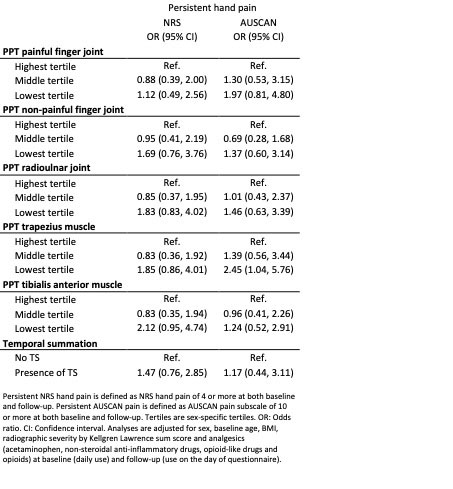Session Information
Session Type: Poster Session D
Session Time: 1:00PM-3:00PM
Background/Purpose: Pain sensitization is part of the complexity of osteoarthritis (OA) pain. We aimed to examine whether pain sensitization by pressure pain thresholds (PPT) and temporal summation (TS) predicts persistent pain in hand OA.
Methods: In these analyses we used longitudinal data from the Nor-Hand study. PPT was measured at baseline at a painful and nonpainful finger joint, at the left radioulnar joint and mid-portions of the trapezius and tibialis anterior muscle with an algometer (Wagner FPIX25); lower PPTs indicate more pain sensitization. TS was tested with a weighted punctuate probe that was applied 10 times at the radioulnar joint at a rate of 1Hz. Participants rated the pain from the 1st, 5th and 10th touch on a Numeric Rating Scale (NRS, range 0-10). TS was defined as increase of 2 points on the NRS during the test. PPTs distant from pathology and TS are considered to reflect central sensitization, while local PPTs at sites of pathology reflect peripheral sensitization. NRS of hand pain the last 24 hours and the Australian/Canadian Osteoarthritis Hand Index (AUSCAN) pain subscale (range 0-20) was collected at baseline and at 3-4 year follow-up. We defined persistent hand pain as present if the participant reported hand pain at or above the level of patient acceptable symptom score (PASS) for NRS (PASS=4) or AUSCAN pain (PASS=10) at both baseline and follow-up for the NRS and AUSCAN pain respectively. We analyzed the relation of sex specific PPT tertiles and TS to persistent pain using logistic regression. Analyses were adjusted for potential confounders, including sex, baseline age, BMI, Kellgren Lawrence sum score of radiographic severity (range 0-128) and use of analgesics at baseline and follow-up.
Results: A total of 205 persons (86% women) with median age of 61 years (IQR 48-70) were included, of whom 189 (95%) fulfilled the ACR criteria for hand OA. Mean (SD) PPT values were; painful fingerjoint 3.9 (1.9), nonpainful finger joint 5.0 (2.2), radioulnar joint 4.4 (2.0), trapezius 4.4 (2.0) and tibialis anterior 5.5 (2.7). A third (28%) of the participants had persistent NRS pain and 24% had persistent AUSCAN pain after a follow-up of mean 3.5 (range 2.8-4.9) years.
There was an overall trend for participants in the lowest sex-specific tertiles of PPT to be more likely to have persistent NRS hand pain than those in the highest sex-specific tertiles, but none were statistically significant (Table). In contrast, those in the lowest tertile for PPT at the trapezius had higher likelihood of persistent AUSCAN pain compared to those in the highest tertile; no other PPT measures were significantly associated with persistent AUSCAN pain (Table). There were also trends of TS being associated persistent NRS and AUSCAN pain, but none reached statistical significance (Table).
Conclusion: In persons with hand OA, central sensitization reflected by low PPTs at the trapezius was associated with persistent AUSCAN pain, and there was a trend for low PPTs and presence of TS being associated with a higher likelihood of persistent NRS hand pain. Our results are the first to demonstrate a longitudinal association of central sensitization and chronic pain in hand OA. They highlight the potential for targeting these pathways in the management of hand OA symptoms.
To cite this abstract in AMA style:
Steen Pettersen P, Neogi T, Mulrooney E, Gløersen M, Hammer H, Haugen I. Does Pain Sensitization by Pressure Pain Thresholds and Temporal Summation Predict Persistent Pain in Persons with Hand OA? [abstract]. Arthritis Rheumatol. 2022; 74 (suppl 9). https://acrabstracts.org/abstract/does-pain-sensitization-by-pressure-pain-thresholds-and-temporal-summation-predict-persistent-pain-in-persons-with-hand-oa/. Accessed .« Back to ACR Convergence 2022
ACR Meeting Abstracts - https://acrabstracts.org/abstract/does-pain-sensitization-by-pressure-pain-thresholds-and-temporal-summation-predict-persistent-pain-in-persons-with-hand-oa/

